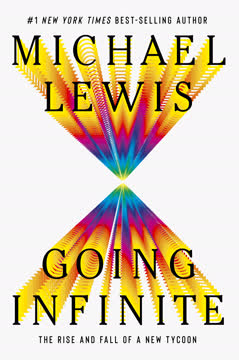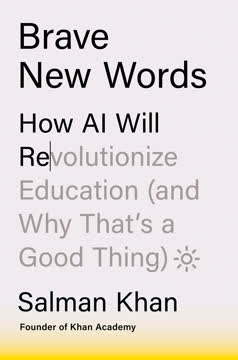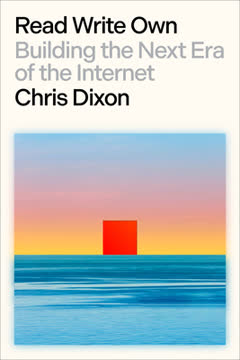Key Takeaways
1. The Internet's Evolution: From Open Protocols to Corporate Control
Today's dominant core internet services—the web (HTTP), email (SMTP), and subscription messaging (RSS)—are open protocols that are distributed across millions of institutions.
The early internet was built on open, decentralized protocols like HTTP and SMTP, which allowed for permissionless innovation and democratic governance. However, as the internet matured, corporate networks emerged, offering advanced features and ease of use but at the cost of centralized control.
The shift to corporate dominance led to high take rates, capricious rule changes, and the stifling of innovation at the network edges. Companies like Facebook, Google, and Amazon now control vast swathes of the internet, creating "walled gardens" that limit user choice and developer freedom. This centralization has resulted in:
- High fees for developers and creators (up to 30% on app stores)
- Limited data portability and interoperability
- Increased user surveillance and data exploitation
- Reduced innovation due to platform risk for startups
2. Blockchain Networks: A New Era of Digital Ownership and Community Governance
Blockchains are the only credible, known architecture for building networks with the societal benefits of protocol networks and the competitive advantages of corporate networks.
Blockchain networks combine the best aspects of protocol and corporate networks, offering open access, community governance, and the ability to attract capital for growth. They enable true digital ownership through tokens, which represent assets, access rights, or governance power.
Key features of blockchain networks include:
- Immutable rules encoded in software
- Low take rates (typically 1-2.5%)
- Community-driven governance
- Interoperability and composability
- Transparent and auditable transactions
These features create a more level playing field for developers, creators, and users, fostering innovation and fair economic distribution. By decentralizing control, blockchain networks aim to restore the original promise of the internet as an open, democratic space.
3. Token Economics: Incentivizing Network Growth and User Participation
Tokens are general-purpose containers for representing ownership.
Token incentives are a powerful tool for building and growing blockchain networks. They solve the "bootstrap problem" by rewarding early adopters and contributors, creating a virtuous cycle of network growth.
Tokenomics, the study of token economies, involves balancing supply (faucets) and demand (sinks) to create sustainable growth. Key concepts include:
- Faucets: Methods of distributing tokens (e.g., airdrops, mining rewards)
- Sinks: Ways to create token demand (e.g., transaction fees, staking)
- Governance tokens: Allowing token holders to vote on network decisions
- Utility tokens: Providing access to network services or features
Well-designed token economies can drive network adoption, fund ongoing development, and align incentives between network participants. This creates a more equitable distribution of value compared to traditional corporate models.
4. The Power of Composability in Software Development
Composability unlocks the best humanity has to offer.
Composability in software allows developers to build on existing components, creating a compounding effect of innovation. This principle is at the heart of open-source development and is now being extended to blockchain networks.
Benefits of composability include:
- Rapid innovation through reusable components
- Lower barriers to entry for developers
- Increased interoperability between applications
- Community-driven improvement of shared resources
Blockchain networks take composability further by making not just code, but also economic and governance systems composable. This allows for the creation of complex, interoperable financial and social systems that can be built and improved upon by a global community of developers.
5. Decentralized Social Networks: Empowering Creators and Users
Blockchain networks are like cities, built from the bottom up by the people who inhabit them.
Decentralized social networks built on blockchain technology aim to address the shortcomings of current corporate-controlled platforms. They offer:
- Lower take rates, allowing creators to earn more
- User ownership of data and social graphs
- Community governance of platform rules and algorithms
- Interoperability between different social applications
By redistributing the value captured by social networks, these platforms could potentially support millions of profitable niches, rather than concentrating wealth in a few large corporations. This model promises to revive the original vision of the internet as a space for diverse, independent voices and communities.
6. The Metaverse and Digital Economies: Redefining Virtual Ownership
The strongest form of an open metaverse would be a collection of composable blockchain networks, each of which meets one of the needs Sweeney describes, and which themselves interoperate, forming a meta-network.
The metaverse, a concept of interconnected virtual worlds, is poised to become a major part of our digital lives. Blockchain technology offers a way to build this metaverse as an open, user-owned system rather than a corporate-controlled one.
Key aspects of a blockchain-based metaverse include:
- True ownership of virtual assets through NFTs
- Interoperable virtual economies
- User-generated content with fair revenue sharing
- Decentralized governance of virtual spaces
This model contrasts with current corporate-owned virtual worlds and games, where users have limited rights and ownership. By enabling real digital ownership and economies, blockchain networks could unleash unprecedented creativity and economic opportunity in virtual spaces.
7. Artificial Intelligence and Content Creation: A New Economic Covenant
AI puts human creators at the beginning of the creative pipeline instead of the end of it.
The rise of AI in content creation presents both challenges and opportunities for creators. While AI can generate content at scale, it relies on human-created training data. Blockchain networks offer a way to create a new economic covenant between AI systems and content creators.
Potential solutions include:
- Token-based compensation for creators whose work is used in AI training
- Blockchain-verified attribution and licensing of AI-generated content
- Decentralized AI models owned and governed by creator communities
This approach could ensure that as AI becomes more prevalent in content creation, human creators remain valued and compensated participants in the creative process.
8. Regulatory Challenges and the Future of Blockchain Innovation
Ideally, policymakers and regulators would clarify the criteria that distinguish securities and commodities and provide a path for new projects to become sufficiently decentralized such that they are regulated as commodities.
Regulatory uncertainty is a significant challenge for blockchain innovation, particularly in the United States. Clear, thoughtful regulation is needed to protect consumers while allowing for innovation.
Key regulatory considerations include:
- Clarifying the distinction between securities and commodities in the context of digital assets
- Creating a pathway for blockchain projects to achieve "sufficient decentralization"
- Balancing consumer protection with the need for permissionless innovation
- Addressing the global nature of blockchain networks in a world of national regulations
The future of blockchain innovation depends on finding a regulatory balance that fosters growth while mitigating risks. By drawing lessons from the early internet era, policymakers have an opportunity to position their countries at the forefront of this transformative technology.
Last updated:
FAQ
What's Read Write Own about?
- Internet Evolution: The book explores the transformation of the internet from an open, permissionless platform to a centralized, corporate-controlled environment.
- Blockchain Networks: Chris Dixon introduces blockchain networks as a new architecture that combines the benefits of protocol and corporate networks, aiming to democratize ownership.
- Digital Ownership: Emphasizes the importance of digital ownership through tokens and how they can reshape the internet landscape, advocating for user control over digital assets.
Why should I read Read Write Own?
- Current Trends Insight: Provides valuable insights into the ongoing evolution of the internet and the implications of blockchain technology.
- Practical Frameworks: Offers frameworks for understanding network operations and how blockchain can disrupt traditional corporate models.
- Vision for the Future: Presents a hopeful vision for the internet's future, emphasizing innovation and community-driven development.
What are the key takeaways of Read Write Own?
- Three Eras of Networks: Outlines the read era, read-write era, and the emerging read-write-own era, each reflecting shifts in user interaction and control.
- Importance of Ownership: Highlights the significance of digital ownership through tokens, empowering users and creators.
- Community-Centric Development: Advocates for blockchain networks prioritizing community involvement and governance.
What are the best quotes from Read Write Own and what do they mean?
- “Your margin is my opportunity.”: Highlights the competitive nature of tech, where high take rates create opportunities for disruption.
- “When the great innovation appears...”: Reflects the unpredictable nature of technological advancements, suggesting innovation often emerges from chaos.
- “The dream of an open network...”: Emphasizes the potential of blockchain technology to restore the original vision of the internet.
How does Chris Dixon define "tokens" in Read Write Own?
- Digital Assets: Tokens are digital assets representing ownership or access within a blockchain network.
- Types of Tokens: Distinguishes between fungible tokens, like cryptocurrencies, and non-fungible tokens (NFTs), each with different use cases.
- Role in Governance: Tokens allow holders to vote on network decisions, aligning community interests with network development.
What is the difference between corporate networks and protocol networks as discussed in Read Write Own?
- Governance Structure: Corporate networks are centrally controlled, while protocol networks are community-driven.
- User Empowerment: Protocol networks empower users by giving them a voice in network development, unlike corporate networks.
- Economic Models: Corporate networks extract value through high take rates, whereas protocol networks aim for low or zero take rates.
How do blockchain networks differ from corporate networks according to Read Write Own?
- Community Governance: Blockchain networks are governed by communities, allowing participant decision-making.
- Lower Take Rates: Typically have lower take rates, meaning more revenue flows to users and creators.
- Transparency and Trust: Operate on transparent protocols, building trust among participants.
What is the significance of digital ownership in the context of blockchain in Read Write Own?
- Restoration of Control: Digital ownership through tokens allows users to control their assets and data.
- Encouragement of Innovation: Ownership encourages creativity and innovation, benefiting the entire community.
- Long-Term Sustainability: Creates a sustainable ecosystem where participants have a vested interest in the network’s success.
What are the challenges of federated networks mentioned in Read Write Own?
- Cross-Server Friction: Independent servers create difficulties in searching and interacting across the network.
- Risk of Protocol Coups: Popular servers can dominate, leading to new centralization forms.
- Sustainability Issues: Struggle with long-term sustainability without a clear economic model.
How does Read Write Own address the future of social networks?
- Decentralized Alternatives: Envisions community-owned social networks, allowing user control over data and interactions.
- Economic Impact: Lower take rates could increase revenue for creators, enabling more creative careers.
- Challenges to Adoption: Acknowledges challenges in achieving mainstream adoption, emphasizing user-friendly designs.
What role do NFTs play in the vision presented in Read Write Own?
- Ownership Representation: NFTs provide digital ownership, allowing creators to monetize work directly.
- Economic Opportunities: Transform the economics of creative industries, enabling sustainable income for artists.
- Community Engagement: Foster deeper engagement between creators and communities, creating a sense of belonging.
What is the "computer versus the casino" concept in Read Write Own?
- Two Cultures of Blockchain: Describes "computer" culture focused on building networks and "casino" culture on speculation.
- Impact on Innovation: Casino culture detracts from blockchain's potential by promoting short-term gains.
- Call for Responsible Engagement: Advocates for a shift towards computer culture, focusing on meaningful projects.
Review Summary
Read Write Own receives mixed reviews. Some praise it as insightful and educational, offering a compelling vision for blockchain's potential to democratize the internet. Others criticize it as overly optimistic, lacking concrete evidence and failing to address key challenges. The book explores internet history, criticizes big tech dominance, and argues for blockchain as a solution. While some find it thought-provoking and well-explained, others see it as rehashing familiar crypto rhetoric. Critics question the author's objectivity given his venture capital background.
Similar Books










Download PDF
Download EPUB
.epub digital book format is ideal for reading ebooks on phones, tablets, and e-readers.




